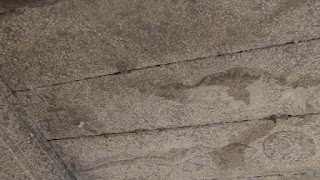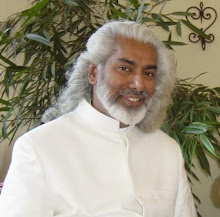
The mandapa is situated a little off the side of the road. Although it was almost completely hidden by bushes and shrubs, I noticed it many times. Passing it from the distance in a car it was just an impression of ancient pillars and a roof. But although I often thought I would like to have a closer look I never stopped the car. Till a week ago.
Something had changed. The shrubs and bushes had been removed, and the mandapa was clearly visible now, and could easily be reached. Whoever did this service, I would like to express my appreciation and thanks to them. So this time I stopped and got out of the car. It is a simple open mandapa, which means a pillared hall. Four rows of six pillars are supporting a flat roof. The central isle is somewhat wider then the side-isles. The back end has been closed off at one time with bricks, and between two pillars on one side an arch shaped entrance had been constructed. This was probably not part of the original structure.
I went inside and started making photos. There are two types of pillars basically, and the mandapa is structurally divided into two parts. The main building is positioned on a raised stone floor, with pillars that are alternating square and octagonal and capped with an unshaped or T-shaped corbel. In front of the main structure four pillars form a kind of porch or veranda. These pillars are alternating square, octagonal, and polygonal (16 facets), and capped with corbels sculpted in a style belonging to approximately the 13th or 14th century. Some pillars have been left unfinished.
I walked around, avoiding the debris lying around, while at the same time photographing the sculpture on the pillars. The best sculpture is found on the square base of the pillars. The base is decorated with nagapadams, cobra heads, rearing at the corners. There are several deities depicted such as Shiva, Murugan and Sarasvati riding her swan, and a figure that might be Vishnu as Mohini. There is a Nandi performing tapas, some bhutagana figures. The upper parts of the columns are either not carved, or carved very roughly with various abstract symbols and figures. It struck me that there are also quite a few depictions of humans, which are usually the donors in a context like this. On the pillar in the South-East corner there is a most peculiar relief of what is undoubtedly a European trader or sailor. From the dress I could gather it was most likely one of the Dutch merchants once settled in Sadras nearby. His coat, hat, high boots, and the sword he wears, indicate his high rank.
Walking around and enjoying the sculpture was a pleasant experience. I am always inspired by the achievements of our ancestors. The pavilion is a pleasant one and the sculpture is very nice, but it is not a master piece. I made what I thought was a final round and was about to go back to the car. But as has happened to me more often in my life, something, some intuition, made me look up, at the ceiling. And there I discovered the hidden treasure of this mandapa.
First my eyes caught the depiction of cobras undulating in front of what I knew to be the Sun and Moon. This is the traditional way of depicting an eclipse. One cobra about to swallow the disk of the Moon. Another depicted as moving in the opposite direction, about to swallow the Sun disk. These are Rahu and Ketu, the ascending and descending nodes of the Moon. Neighboring these eclipse depictions are mythological and real animals. A deer, several sea-creatures, one with a human face, monkeys. A little further I discovered the mythological being that had been calling me for many years now. The Indian sphinx or purushamriga (human-beast) faces a multi-facetted lotus. Opposite this sphinx the saint Kanappa is depicted in the act of giving his eyes to Shiva, a well know legend from the Shaivite tradition.
A little further a scorpion with a human face and a two-headed bird are facing each other. Another multifaceted lotus is on the slab next to them. And further two fish face each other. I was stunned with this unexpected treasure of sculpture with so much meaning and went back inside the mandapa to inspect the ceiling there. Several more eclipses are depicted, as well as mythological animals and lotuses. I saw more pairs of fish, two cobras almost touching with tiny figures near their heads. Another scorpion with a human face is situated opposite a tortoise.
So many questions arise from this iconography and from these symbols. This mandapa is a remarkable astronomical monument. I feel and could say it is an astro-archaeological discovery of high significance. It obviously commemorates several solar and lunar eclipses so the next question was which astronomical events were depicted here? I used the Solar and Lunar Eclipse Explorer calculators on the Nasa Eclipse Website and looked for what would have been extra-ordinary celestial events in the past that would fit the architecture and sculptural style.
In the last decade of the 13th century an extra-ordinary series of three solar eclipses that were total over parts of South India took place. Where this mandapa is situated these eclipses did not reach totality, according to the eclipse calculator, but they were very near totality. And the variability of DeltaT leaves room for the possibility for one or more of these eclipses to have been total to the eye-witnesses here after all. These eclipses took place on the 5th of July 1293, the 28th of October 1296 and on the 21st of February 1300 (astronomers use dates from the Julian calendar for events before 1582). In the same period there were an unusual high number of total Lunar eclipses; 1284 (2), 1287 (2), 1291 (2), 1294, 1295 and 1298.

When we look at the style of the sculpture and architecture of the pavilion the period around 1300 would be a proper fit. Also the clothes and hairstyle of the people depicted agree well with this date. Except for the European sailor or trader. He seems to be out of place. Was this figure added at a later date? This relief is executed in a very different style from the others, and may be a later addition which gives this mandapa an even greater historical significance.
But it is the astronomy in combination with the iconography that secures the meaning and the date of this pavilion and its unique iconography. The last in the series of the three solar eclipses that had the phase of totality over South India occurred on the 21st of February 1300. It being a New Moon day infers that is must have been the day before or after Maha Shiva Ratri, which is always celebrated on the night of New Moon in the month of Magha (Masi Masa in Tamil). The Tamil traditional calendar is a sidereal calendar, so the month would have fallen differently with respect to the Western calendar from today. And the Julian calendar is used to calibrate the dates. But this date definitely translates into Maha Shiva Ratri or New Moon night in the period of February-March for the year 1300.

And this explains the presence of the sphinx or purushamriga. Because the Indian sphinx is especially connected with Maha Shiva Ratri, as it is the night that devotees run a race called Shiva Ottam in Kanya Kumari district in commemoration of the race between Bhima and the sphinx in the Mahabharata. The presence of Kannapa also relates to Maha Shiva Ratri. The multi facetted lotus medallion in between them is the representation of the total solar eclipse, with the lotus petals representing what contemporary astronomers call Bailey’s Beads and the streamers of the sun’s corona, I think. It expresses in an appropriate artistic form the vision and experience of a total solar eclipse. This relief also expresses the significance of an eclipse as a major spiritual event.
Besides this total eclipse on the 21st February 1300, the depiction of several nagas or cobras with solar and lunar disks in front of them on the ceiling of this pavilion express the registration of this series of solar and lunar eclipses that had a special significance for the eyewitnesses. They commemorated these events with the building of this mandapa and recorded them by carving these astronomical symbols on its ceiling. The reliefs are in a way 14th century photos of these astronomical events.
Eclipses, both solar and lunar, are of great spiritual significance and are seen by the Vedic tradition as moments of great spiritual power and potentiality. People who follow a spiritual path (sadhana) would perform meditation and rituals because of the special energy generated by the eclipse. The Panchangam or almanac would have predicted the eclipses accurately and people would have been forewarned and would have prepared for them.
Eclipses are also often interpreted as forewarnings of disaster and adversity, depending on the astrological circumstances in which they occur. The reality is that just a little over ten years later South India was invaded. This invasion was a disaster for the civilization of South India, and nothing would ever be the same again. The pavilion as a whole expresses the importance the people of the time attached to this series of celestial events.
When we summarize the significance of this remarkable mandapa we see it is both an astronomical and a historical monument of unusual significance. A series of three solar eclipses that were total over South India concludes with one that coincides with the date of the spiritual festival of Maha Shiva Ratri, one of the most important religious festivals in the traditional calendar. A decade later South India is invaded and thrown into chaos and despair. This small mandapa on the side of a modern road commemorates these astronomical and historical events, and helps us to understand a decisive event of the past, and how it was experienced by those who witnessed it.










